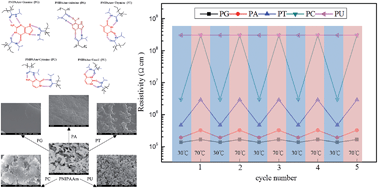Characterization of poly(N-isopropylacrylamide)–nucleobase supramolecular complexes featuring bio-multiple hydrogen bonds†
Abstract
In this study we employed poly(N-isopropylacrylamide) (PNIPAAm) as a matrix that we hybridized with five different nucleobase units (adenine, thymine, uracil, guanine, cytosine) to generate PNIPAAm–nucleobase supramolecular complexes (PNSCs) stabilized through bio-multiple hydrogen bonds (BMHBs). These nucleobase units interacted with PNIPAAm through BMHBs of various strengths, leading to competition between the BMHBs and the intramolecular hydrogen bonds (HBs) of PNIPAAm. The changes in morphology, crystalline structure, and thermoresponsive behavior of PNIPAAm were related to the strength of its BMHBs with the nucleobases. The strengths of the BMHBs followed the order guanine > adenine > thymine > cytosine > uracil, as verified through analyses of Fourier transform infrared spectra, lower critical solution temperatures, and inter-association equilibrium constants. The PNSCs also exhibited remarkable improvements in conductivity upon the formation of BMHBs, which facilitated proton transport. The neat PNIPAAm film was an insulator, but it transformed into a semiconductor after hybridizing with the nucleobases. In particular, the resistivity of the PNIPAAm–guanine supramolecular complex decreased to 1.35 × 105 ohm cm. The resistivity of the PNIPAAm–cytosine supramolecular complex increased significantly from 5.83 × 106 to 3 × 108 ohm cm upon increasing the temperature from 40 to 50 °C, suggesting that this material might have applicability in thermo-sensing. The ability to significantly improve the conductivity of hydrogels through such a simple approach involving BMHBs might facilitate their use as novel materials in bioelectronics.


 Please wait while we load your content...
Please wait while we load your content...